The SEO Impact of a Poor Homepage Copy and Navigation Redesign

While there are plenty of technical search engine optimization (SEO) aspects involved in website visibility, one often overlooked aspect is homepage copy and navigation. The copy that you present to visitors, as well as how you present it, can have a direct impact on search engine results page rankings (SERPs).
In this post, I’ll highlight the ramifications of not following SEO best practices when redesigning homepage copy and navigation. I’ll review an NP Digital client case study that shows why following the data is always a good idea.
Let’s jump in!
What Makes Poor Homepage Copy and Navigation?
When it comes to evaluating the quality of your homepage copy and navigation, there are three elements to take into account:
- Search engine optimization. A homepage that has not been optimized for SEO will perform poorly on SERPs.
- User experience. A homepage that doesn’t take user experience into account (e.g. intrusive popups, low-quality copy) will suffer from high exit rates and low engagement.
- Accessibility. A homepage that doesn’t follow Web Content Accessibility Guidelines (WCAG) will make it difficult for all users to navigate the website effectively. This can directly affect user experience while also impacting SEO.
Poor homepage copy and navigation is anything that misses out on one or more of the above three elements.
How NPD Helped a Client with Their Poor Homepage Copy
NP Digital is my digital marketing agency. My team and I work with clients worldwide to help them uncover their full potential and accelerate their growth.
As part of our work, NP Digital consults with businesses when they want to make big changes to their strategy.
One of our clients recently embarked on such a change.
Our client informed our team that they were about to embark on a homepage copy and navigation redesign. They told us that this change would take place in early February of 2023, and they asked us to do an analysis to determine the prospective impact of the homepage redesign.
We provided data to support that their homepage keyword rankings were moving in the right direction and that they needed to proceed with caution and a strong SEO strategy. However, our client forged ahead and completed the homepage copy and navigation changes in February.
We leveraged Google Search Console and Semrush to analyze the lead up to the homepage redesign and what happened afterwards. Our findings show the impact of not following SEO best practices when redesigning homepage copy and navigation so you can learn from our client’s mistakes.
How NPD Explained the Homepage Redesign Impact
We looked at pre-redesign and post-redesign metrics to determine what impact, if any, our client’s homepage redesign had on SEO and user engagement.
Pre-Redesign
Prior to the redesign, our goal was to determine whether the current homepage rankings were trending in the right direction. From August 2022 to January 2023, the number of homepage keywords in position one through three on SERPs increased from 154 to 205. The total number of ranking keywords in positions one through 20 increased from 685 to 880.

Of course, we know that rankings translate to clicks and impressions. So how was the client performing prior to the redesign?
These are the Google Search Console results for non-branded queries for clicks from August 2022 through January 2023:
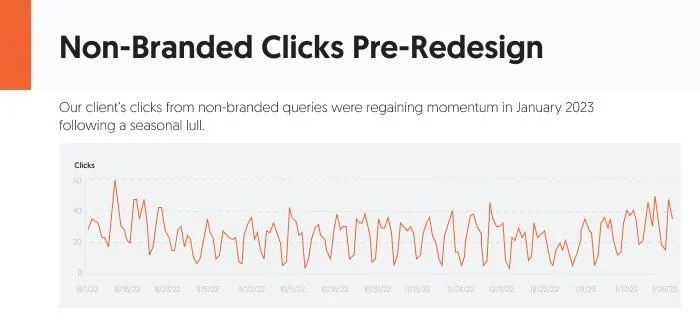
You can see that coming out of August, our client was in a seasonal lull. However, clicks started to steadily increase in the month of January.
This is what we would expect to see considering the marked increase in keywords in the top three positions from August 2022 through January 2023.
We see a similar, but even more prominent increase, when looking at impressions of those same non-branded queries from August 2022 through January 2023:
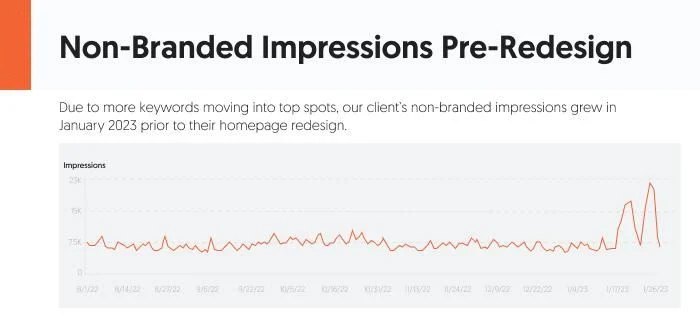
Do you notice a pattern here?
The greatest gain we see in clicks and impressions occurs between December and January. Why? Well, when you look back to the keyword rankings from Semrush, you’ll notice that 30+ additional keywords moved into the top three positions between December and January alone.
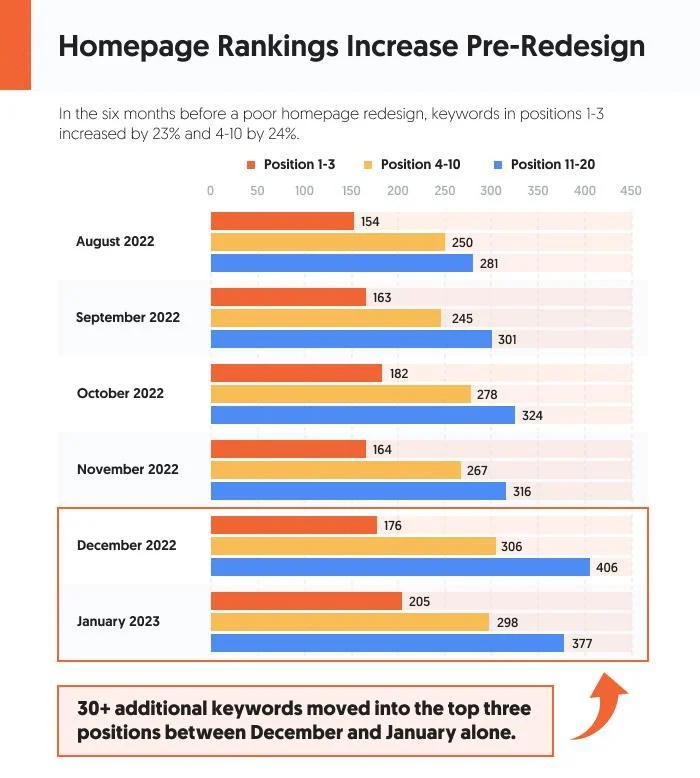
This causes a nice spike in impressions towards the end of January.
So what was our recommendation to our client?
NP Digital noted that our client’s keywords in the top 10 positions were increasing month over month and trending in a positive direction. We recommended a slow and steady change to the homepage, if changes needed to be implemented at all.
Due to pressure from stakeholders, however, the client went ahead with the homepage redesign which included changes to copy and metadata (e.g. title tag, meta description, and headers).
Post-Redesign
So what happened after the client rolled out these sudden updates to the homepage?
Unfortunately, our client suffered losses in keyword rankings and, as a direct result, saw a decrease in traffic.
The homepage redesign launched on February 2nd. As a result, our client saw a drastic decline in both branded and non-branded terms as well as overall clicks.
Our client ended January 2023 on a high, with 205 keywords ranking in positions one through three and 298 keywords ranking in positions four through 10. This dropped to 187 keywords ranking in the top three positions in February and 159 keywords ranking in the top three positions in March. April and May followed suit.
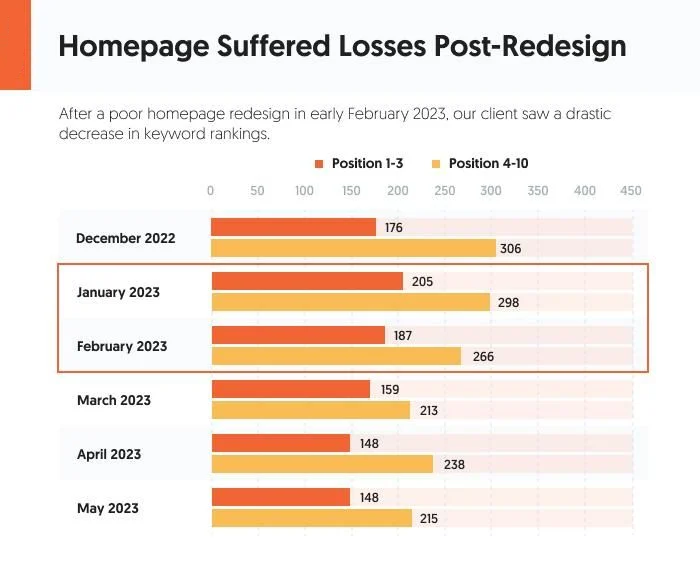
The loss in keyword rankings almost immediately translates to a loss in clicks and traffic.
There is a significant drop in clicks noted on February 3rd (the day after the redesign):
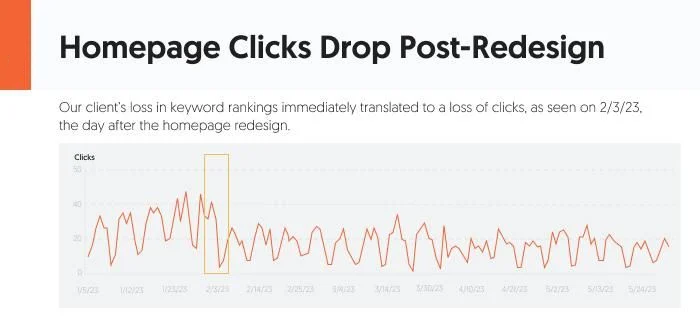
While there are some notable peaks in February and beyond, those peaks are lower than the peaks pre-February. The dips are also significantly lower than pre-redesign with some even reaching near zero (e.g. the dip seen between March 19th and March 30th).
Once again, you can see the drop in clicks from January to February and the following months.
Impressions saw much the same as clicks, with less peaks and more significant dips noted post-redesign:
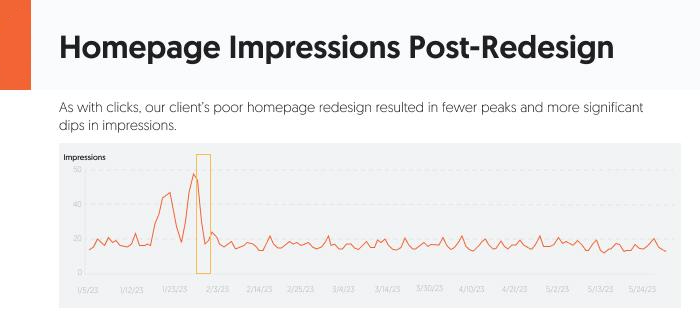
This is a direct result of keyword rankings decreasing and being deprioritized (lower down) within the SERPs.
All these metrics were drastically impacted by changing the copy on the homepage and the metadata. By not maintaining a focus on the keywords that drove value to the homepage, there was a drastic traffic loss that continued into June.
Tips to Improve Your Homepage Copy and Navigation
If the case study above has taught us anything, it’s that sudden and poorly researched homepage redesigns can be detrimental to your website’s performance.
If you have solid homepage copy that is performing, then changes should be minimal and only done for solid analytical reasons.
What if your homepage copy isn’t performing, though?
Then it’s time to improve your homepage copy and navigation, the right way. Here’s how.
Keep Reading Level in Mind
The homepage of your website is the access point for your website’s visitors. You want it to be easy to read and even easier to digest.
One way to achieve that is to keep reading level at about a sixth-grade level .
This ensures the greatest number of visitors can understand your homepage copy.
Now you may be asking, how can I know if I’m writing at a sixth-grade level?
Fortunately, there are tools like Hemingway Editor that can help.
Just take a look at the original text in this section:
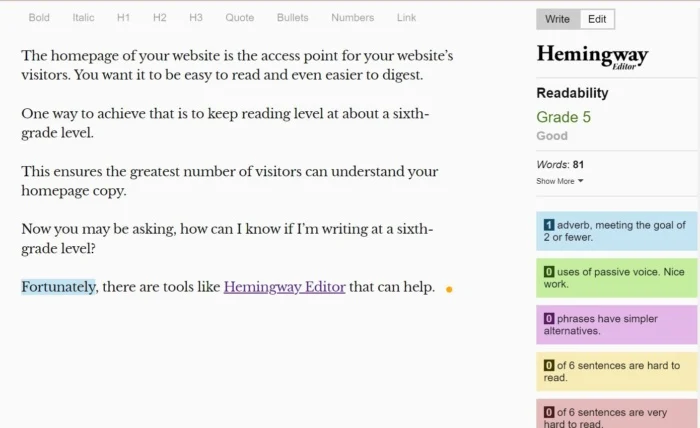
You’ll notice that one sentence is highlighted in yellow. This indicates that it’s hard to read. While the text above was graded at the sixth-grade level, I tweaked it to rephrase the hard-to-read sentence:
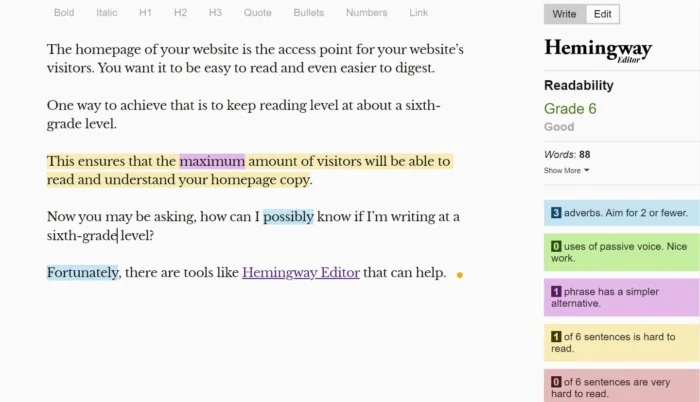
Now it’s at a fifth-grade level which is even better!
The goal here is to ensure that the majority of people who access your website—and certainly your homepage—can understand and engage with the content.
Implement a Logical Heading Structure
Headings are an important part of any webpage. They are useful for both humans and search engine crawl bots which means it’s essential that you get them right.
The most logical heading structure is one that starts with H1 and goes all the way down to H6. There should be just one H1 for each webpage (including the homepage) and it should be used for the page title. The rest of the headings can be used as much or as little as necessary.
However, you do want to ensure you’re using them correctly to avoid confusion.
This means that the main sections of your homepage or webpage should have an H2. If you need to make a further point that relates to the H2, you can use an H3 and so on.
A common mistake that I see is text styled to look like a heading (e.g. bolded, enlarged font) but it’s not properly classified as one. The problem here is that you may be able to fool readers, but you can’t fool crawl bots. This can have a detrimental effect on your rankings.
So use a consistent and logical heading structure on your website and ensure that your headers are appropriately classified as such on your website.